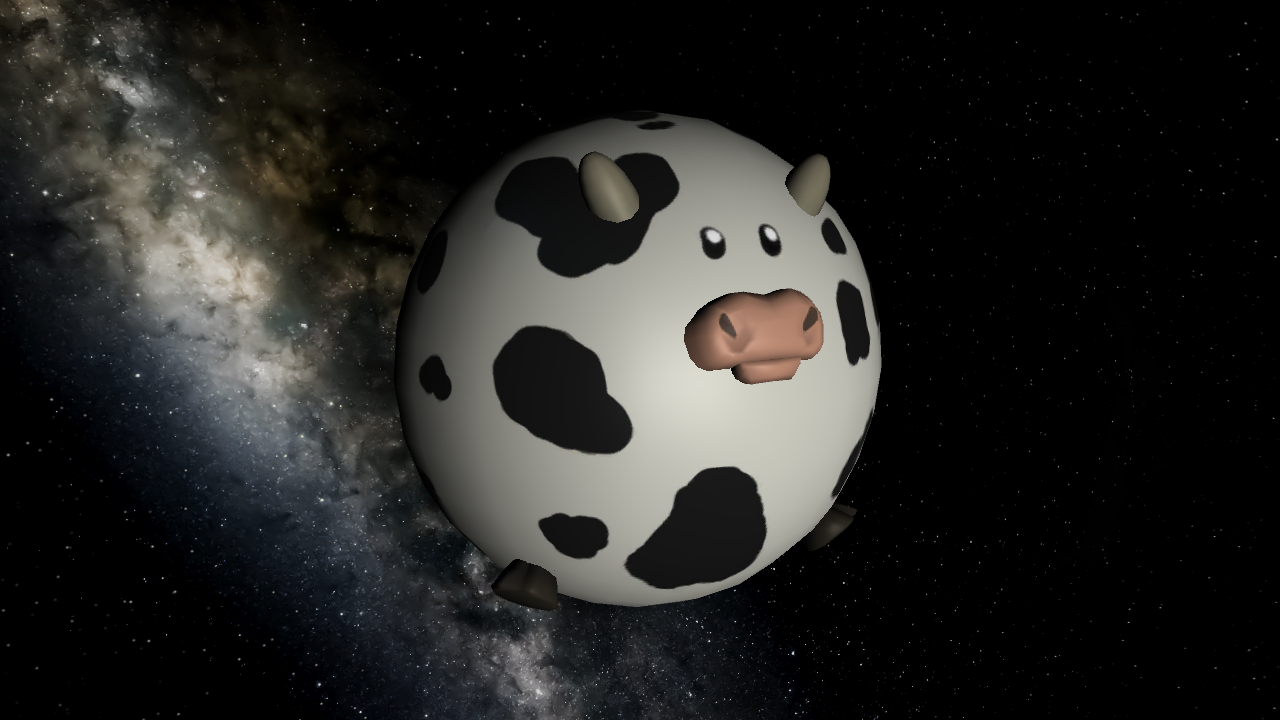Universe Sandbox for Mobile | Update 2 | Challenges of Mobile Development
[previewyoutube][/previewyoutube]
Collisions and surface simulation already run smoothly in Universe Sandbox on mobile devices.
Bringing the complete Universe Sandbox experience to mobile is an exciting and challenging project, and while development was stalled while hiring a new user interface engineer, we are back on track! While we still don’t have a release date for Universe Sandbox on mobile, we want to share our recent progress and current obstacles.
For an overview of our plans for Universe Sandbox on mobile devices, you can read our first Mobile DevLog.
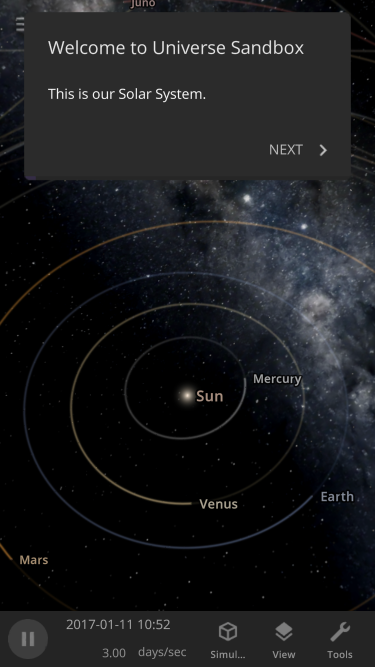 Making our user interface work in portrait mode is an added challenge when adapting it for small screens.
Making our user interface work in portrait mode is an added challenge when adapting it for small screens.
[h3]Pocket-Sized Complexities[/h3]
We’ve been thinking about Universe Sandbox mobile for a long time and have been developing our panels and buttons to be easy to view and use on small screens for years. In fact, Universe Sandbox mobile is built from the exact same code as the version you already know and love, so it will have the same features and user interface as the desktop experience.
This shared codebase means you can enjoy any new features or improvements we add to Universe Sandbox on any device, whether you’re on a desktop, laptop, VR headset, phone, or tablet.
While these are seemingly simple goals, they create complex design challenges, including
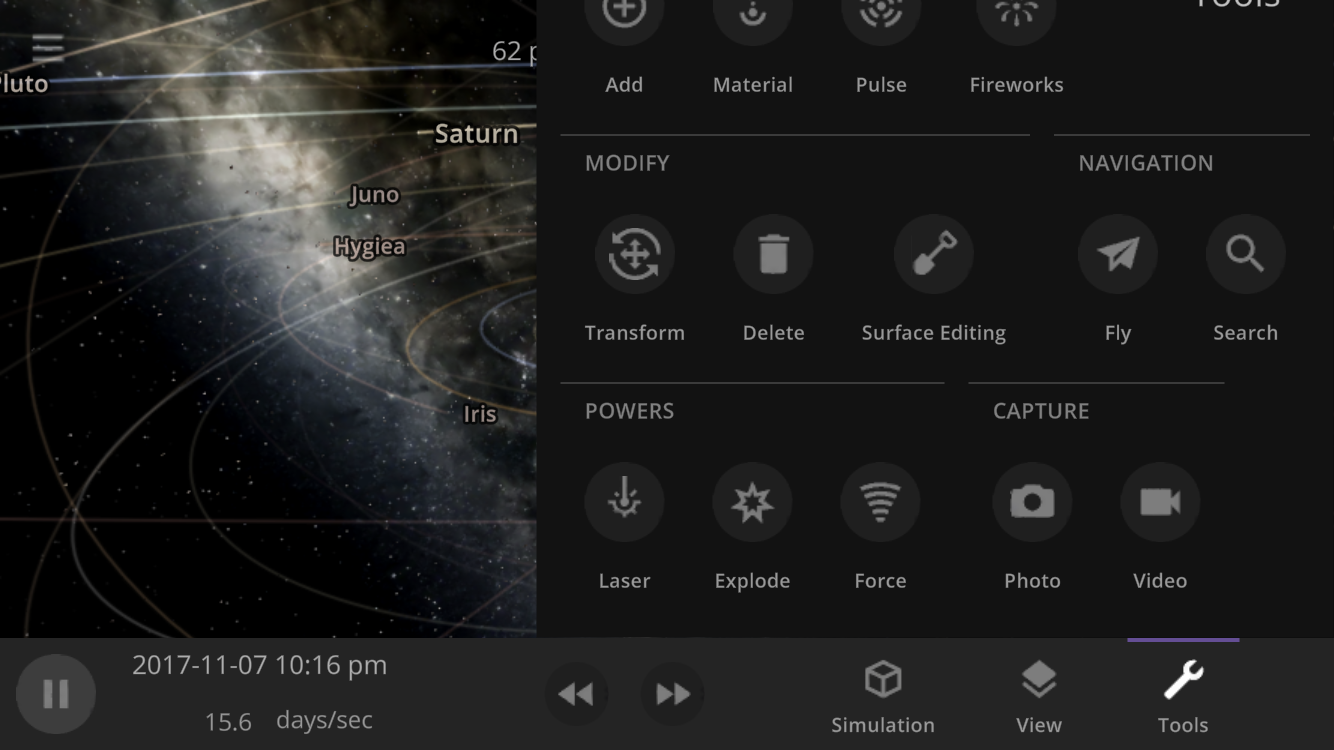 Dynamically resizing panels (this tool panel is cut off) and automatically moving the center of your view so you can always see what you're looking at (moving the Sun hidden behind the tool panel to the empty space on the left) is just one example of the user interface work we still need to do. This is a work in progress.
Dynamically resizing panels (this tool panel is cut off) and automatically moving the center of your view so you can always see what you're looking at (moving the Sun hidden behind the tool panel to the empty space on the left) is just one example of the user interface work we still need to do. This is a work in progress.
[h3]Under New (Layout) Management[/h3]
While most other simulators and games have a different user interface for their mobile and desktop versions, we want ours to use the exact same interface for all platforms. We think we’re among the first to do this, but if you know of another or have done this with your game, please let us know! You can see what Universe Sandbox mobile might look like right now (including why we haven’t released it yet) by resizing the Universe Sandbox window on your computer to the size of your phone (since our user interface dynamically responds to your window size).
[previewyoutube][/previewyoutube]
[previewyoutube][/previewyoutube]
Showing multiple panels simultaneously in both landscape and portrait orientations while still seeing the simulation on a small screen is one of the biggest challenges of mobile development. This is a work in progress.
While we are still making performance improvements so Universe Sandbox can run smoothly on phones, our primary obstacle in mobile development is ensuring our interface is usable on a small touch screen like a phone. We’ve started tackling it by designing a system to intelligently hide and reveal panels as they open and close, which we’re calling our Dynamic Layout System.
While creating this system will take time, it should allow future improvements and new features to work in Universe Sandbox without any extra development, regardless of whether you’re playing on mobile or desktop. That means we’ll have more time to work on new features instead of spending time implementing the same feature in two different ways.
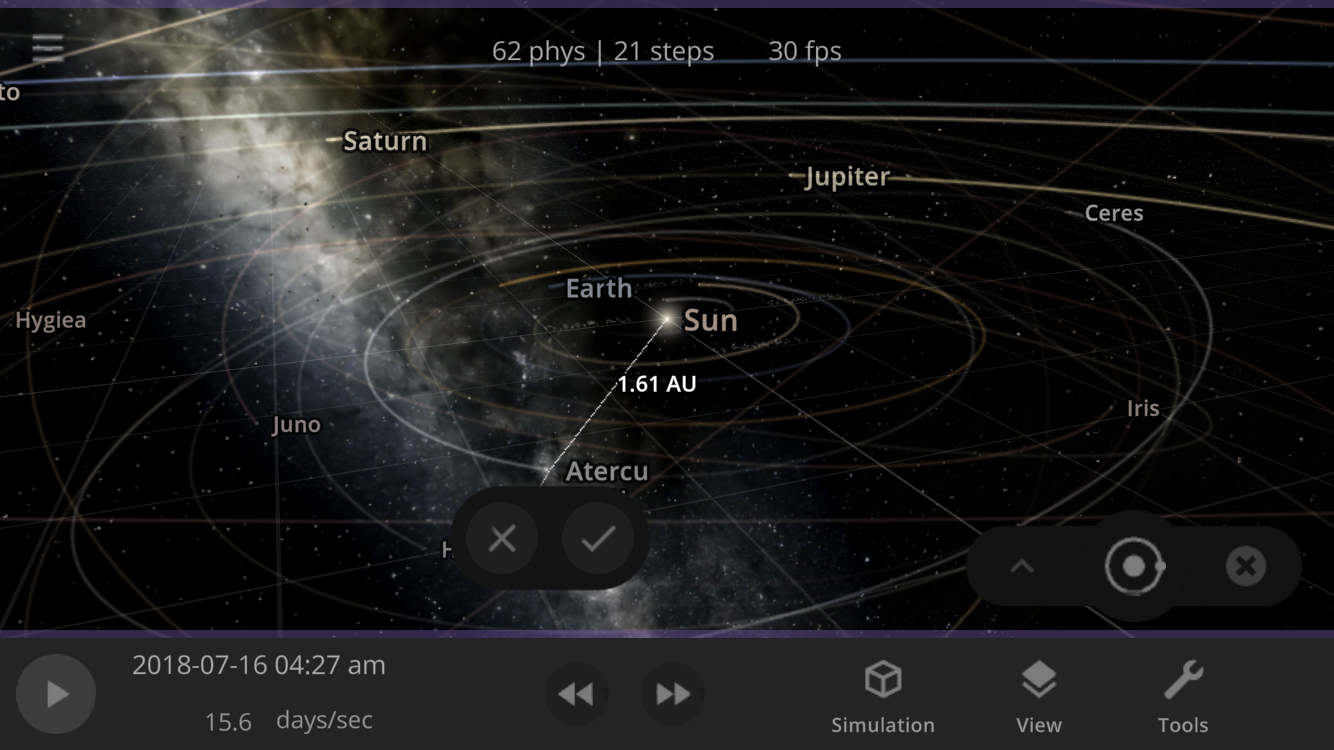 One new design we have is a step to confirm placing an object, helping it end up where you want it. This is a work in progress.
One new design we have is a step to confirm placing an object, helping it end up where you want it. This is a work in progress.
[h3]Current Progress[/h3]
We’ve been researching the best way to create this dynamic panel management system and have made significant progress implementing it within Universe Sandbox.
There’s still other work to be done, and we do not have a release date or official price for mobile, but we’re still planning on it being a one-time paid app with no ads or in-app purchases.
We have yet to finalize the minimum device requirements for the mobile version, but it will likely require a modern device with decent specs. We will share more about hardware requirements as soon as we finalize them.
Taking a feature-rich, user-interface-heavy desktop game and porting it to mobile presents many challenges, but we are excited to tackle them and create an experience unlike any other at your fingertips.
To receive updates about mobile, like this one, sign up for our mailing list:
http://universesandbox.com/mobile/
[previewyoutube][/previewyoutube]
Earth and Moon collide in Universe Sandbox on a mobile device. While collisions and surface simulations already run smoothly, our guide panels still need to be updated to work with our new Dynamic Layout System.
Join our community discussions on our Steam Forum and our official Discord community.
Collisions and surface simulation already run smoothly in Universe Sandbox on mobile devices.
Bringing the complete Universe Sandbox experience to mobile is an exciting and challenging project, and while development was stalled while hiring a new user interface engineer, we are back on track! While we still don’t have a release date for Universe Sandbox on mobile, we want to share our recent progress and current obstacles.
For an overview of our plans for Universe Sandbox on mobile devices, you can read our first Mobile DevLog.
 Making our user interface work in portrait mode is an added challenge when adapting it for small screens.
Making our user interface work in portrait mode is an added challenge when adapting it for small screens.[h3]Pocket-Sized Complexities[/h3]
We’ve been thinking about Universe Sandbox mobile for a long time and have been developing our panels and buttons to be easy to view and use on small screens for years. In fact, Universe Sandbox mobile is built from the exact same code as the version you already know and love, so it will have the same features and user interface as the desktop experience.
This shared codebase means you can enjoy any new features or improvements we add to Universe Sandbox on any device, whether you’re on a desktop, laptop, VR headset, phone, or tablet.
While these are seemingly simple goals, they create complex design challenges, including
- How to automatically arrange panels and adjust your view so you can focus on controlling the simulation, not having to manage the user interface
- Switching between multiple panels, like an object's properties, data views, and guide instructions, on small screens in landscape and portrait modes
- Overhauling our simulation tools (like explode, laser, and planetscaping), to adapt to all screen sizes
 Dynamically resizing panels (this tool panel is cut off) and automatically moving the center of your view so you can always see what you're looking at (moving the Sun hidden behind the tool panel to the empty space on the left) is just one example of the user interface work we still need to do. This is a work in progress.
Dynamically resizing panels (this tool panel is cut off) and automatically moving the center of your view so you can always see what you're looking at (moving the Sun hidden behind the tool panel to the empty space on the left) is just one example of the user interface work we still need to do. This is a work in progress.[h3]Under New (Layout) Management[/h3]
While most other simulators and games have a different user interface for their mobile and desktop versions, we want ours to use the exact same interface for all platforms. We think we’re among the first to do this, but if you know of another or have done this with your game, please let us know! You can see what Universe Sandbox mobile might look like right now (including why we haven’t released it yet) by resizing the Universe Sandbox window on your computer to the size of your phone (since our user interface dynamically responds to your window size).
[previewyoutube][/previewyoutube]
[previewyoutube][/previewyoutube]
Showing multiple panels simultaneously in both landscape and portrait orientations while still seeing the simulation on a small screen is one of the biggest challenges of mobile development. This is a work in progress.
While we are still making performance improvements so Universe Sandbox can run smoothly on phones, our primary obstacle in mobile development is ensuring our interface is usable on a small touch screen like a phone. We’ve started tackling it by designing a system to intelligently hide and reveal panels as they open and close, which we’re calling our Dynamic Layout System.
While creating this system will take time, it should allow future improvements and new features to work in Universe Sandbox without any extra development, regardless of whether you’re playing on mobile or desktop. That means we’ll have more time to work on new features instead of spending time implementing the same feature in two different ways.
 One new design we have is a step to confirm placing an object, helping it end up where you want it. This is a work in progress.
One new design we have is a step to confirm placing an object, helping it end up where you want it. This is a work in progress.[h3]Current Progress[/h3]
We’ve been researching the best way to create this dynamic panel management system and have made significant progress implementing it within Universe Sandbox.
There’s still other work to be done, and we do not have a release date or official price for mobile, but we’re still planning on it being a one-time paid app with no ads or in-app purchases.
We have yet to finalize the minimum device requirements for the mobile version, but it will likely require a modern device with decent specs. We will share more about hardware requirements as soon as we finalize them.
Taking a feature-rich, user-interface-heavy desktop game and porting it to mobile presents many challenges, but we are excited to tackle them and create an experience unlike any other at your fingertips.
To receive updates about mobile, like this one, sign up for our mailing list:
http://universesandbox.com/mobile/
[previewyoutube][/previewyoutube]
Earth and Moon collide in Universe Sandbox on a mobile device. While collisions and surface simulations already run smoothly, our guide panels still need to be updated to work with our new Dynamic Layout System.
Join our community discussions on our Steam Forum and our official Discord community.


 Before
Before After
After Before
Before After
After Before
Before After
After
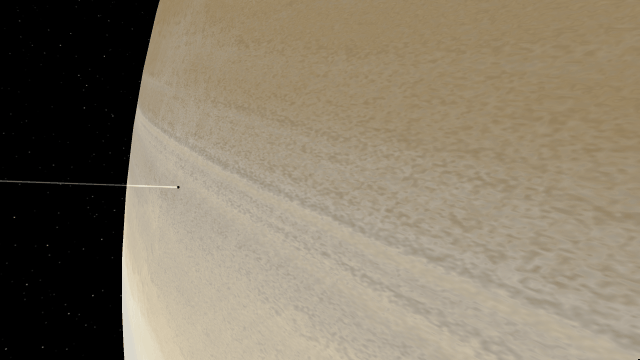 Before
Before After
After Before
Before After
After

 Before
Before After
After Before
Before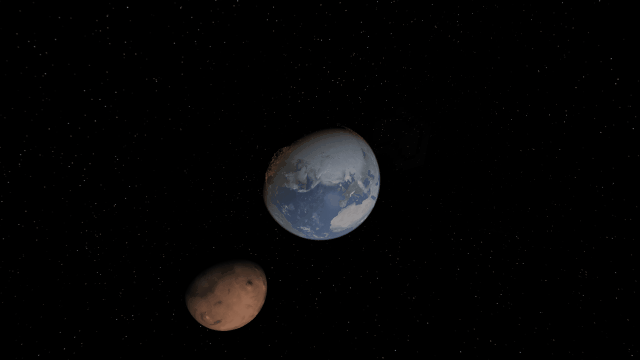 After
After Before
Before After
After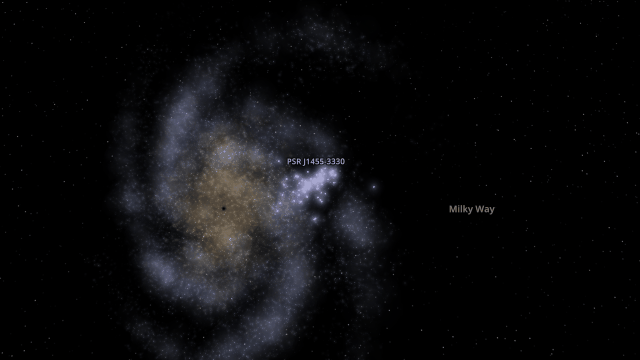



 Before
Before After
After

 The Milky Way galaxy with a trail for every nebula in the galaxy using our upcoming physics architecture improvements. Currently, trails are only shown for some nebulae due to performance limitations. The colors show how many times the orbit of a nebula must be computed to maintain physical accuracy. Blue means fewer computations, while red means more.
The Milky Way galaxy with a trail for every nebula in the galaxy using our upcoming physics architecture improvements. Currently, trails are only shown for some nebulae due to performance limitations. The colors show how many times the orbit of a nebula must be computed to maintain physical accuracy. Blue means fewer computations, while red means more.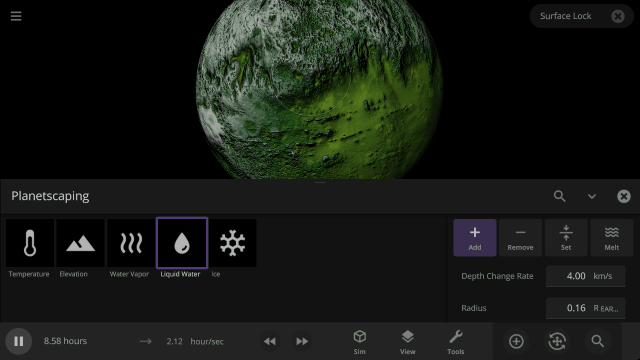 Demonstrating highlights from 2022, including the Force Spin tool, Settle Water button, and Auto Simulation Speed.
Demonstrating highlights from 2022, including the Force Spin tool, Settle Water button, and Auto Simulation Speed.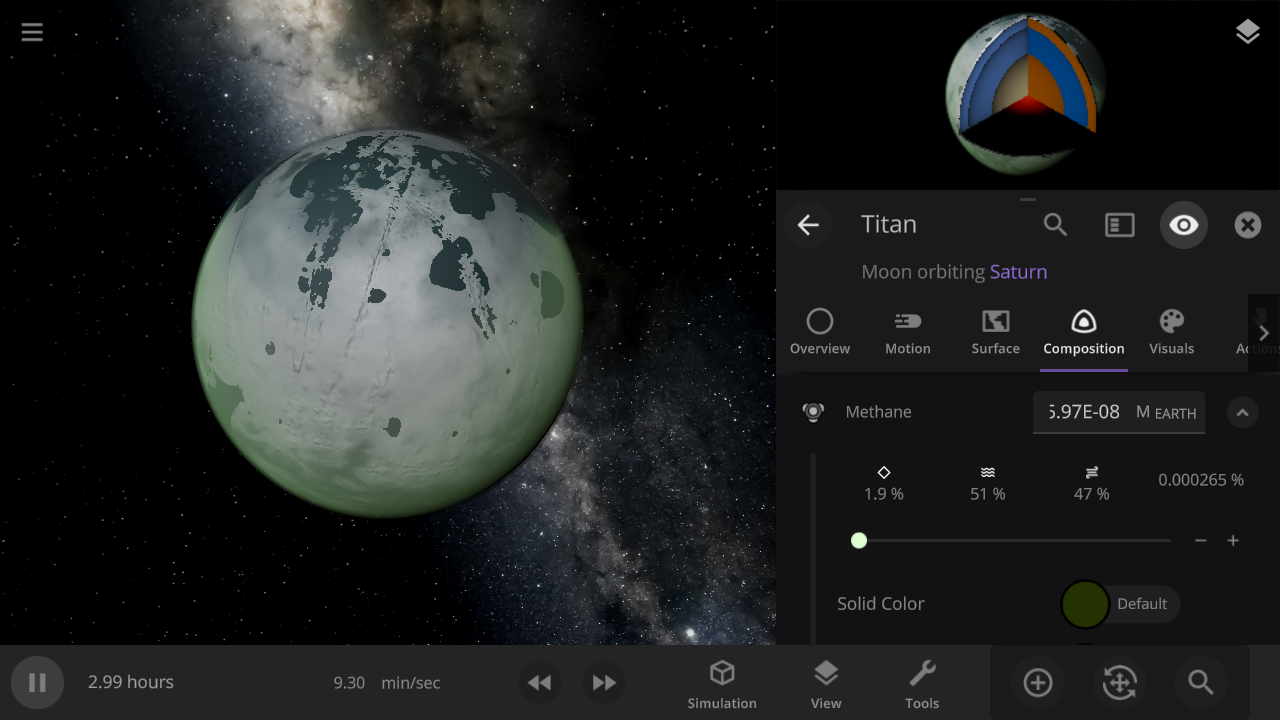 Titan with realistic lakes of liquid methane. Titan’s properties include the amount of methane and the percentage in each phase (solid, liquid, and gas). Material colors are manually adjusted to help see the lakes. This feature and interface are a work in progress.
Titan with realistic lakes of liquid methane. Titan’s properties include the amount of methane and the percentage in each phase (solid, liquid, and gas). Material colors are manually adjusted to help see the lakes. This feature and interface are a work in progress. This graph shows the calculated density of the materials of Earth based on their depth. You can see the density of Earth increases as you move towards its core. The cut-away view of Earth shows the individual materials, temperature, and phase of each material from the inside out. This feature and interface are a work in progress.
This graph shows the calculated density of the materials of Earth based on their depth. You can see the density of Earth increases as you move towards its core. The cut-away view of Earth shows the individual materials, temperature, and phase of each material from the inside out. This feature and interface are a work in progress.
 Liquid materials added to the surface of a planet with the Planetscaping tool will blend over time. Artificial coloring is used here to help differentiate materials. This feature and interface are a work in progress.
Liquid materials added to the surface of a planet with the Planetscaping tool will blend over time. Artificial coloring is used here to help differentiate materials. This feature and interface are a work in progress.
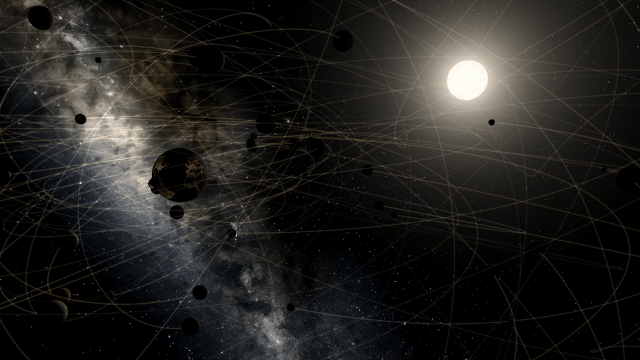 While many moons orbiting Earth and colliding are beautiful, the more objects in a simulation, the more computationally demanding it is.
While many moons orbiting Earth and colliding are beautiful, the more objects in a simulation, the more computationally demanding it is.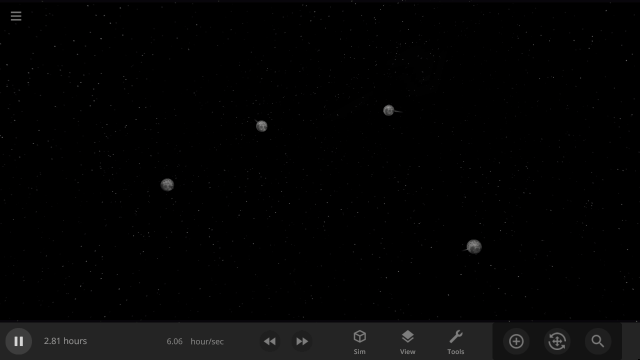 Before - Our current gravity simulation has small inaccuracies, so the trails of these moons don't show a fish.
Before - Our current gravity simulation has small inaccuracies, so the trails of these moons don't show a fish. After - Improvements to our gravity simulation allow these moons to orbit with trails that clearly show a fish.
After - Improvements to our gravity simulation allow these moons to orbit with trails that clearly show a fish.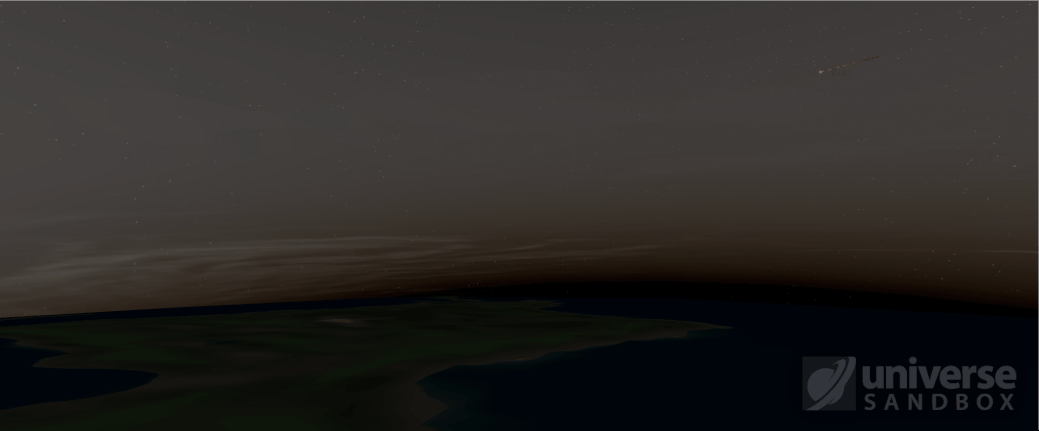 A meteor burns up as it flies through Earth’s atmosphere. Adding atmospheric drag is a work in progress.
A meteor burns up as it flies through Earth’s atmosphere. Adding atmospheric drag is a work in progress.
 As moons collide, they get hot enough to glow and emit light on the surrounding moons. Non-stellar objects emitting light is a work in progress.
As moons collide, they get hot enough to glow and emit light on the surrounding moons. Non-stellar objects emitting light is a work in progress. A habitable planet with vegetation that dies off after an asteroid impact. Vegetation response to temperature is already implemented, but in the future, additional factors beyond collisions will impact vegetation habitability.
A habitable planet with vegetation that dies off after an asteroid impact. Vegetation response to temperature is already implemented, but in the future, additional factors beyond collisions will impact vegetation habitability.






